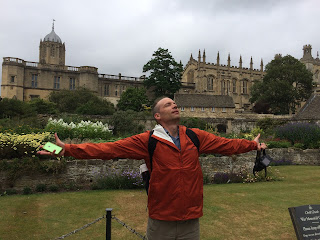About two months ago I received an email from Bishop Sudarshana Devadhar, episcopal leader of the Boston area. He and his wife, Prema, had just volunteered at Rachel’s Kitchen (pictured above with Pastor Earl Dionne and Barbara Loyer), which is housed at the Rachel S. Harlow United Methodist Church in Windsor, Vermont. The Bishop shared with me that the pastor, Earl Dionne, had read my book, A Missionary Mindset, and that it had helped him discover the mission that became Rachel’s Kitchen, a ministry that provides breakfast five times a week in an area of the country where food insecurity is prevalent.
One seldom knows the impact a book might have and so it is a special serendipity that the Bishop shared his experience. Upon arriving at the Windsor church, Prema Devadhar pitched right in, cooking up pancakes on the griddle. The bishop engaged in conversation with those who came for breakfast, including many children. When school is out, as it was in August when the Devadhars volunteered, children don’t have the one nutritious meal provided at lunchtime.
Providing food is important. Studies indicate that 12 percent of people living in Windsor county, Vermont, experience food insecurity. But Rachel’s Kitchen provides something more: a sense of community. There are many regulars among the 52 or so people who come for breakfast Monday through Friday, from 6:45 to 10:30 am. The regulars know each other on a first name basis. They look forward to seeing one another.
As reported in a local newspaper, Valley News, Rachel’s Kitchen is a large room with a kitchen next to it below the worship space of the United Methodist Church, located at 165 Main Street in Windsor. They serve fruit, coffee, juices, muffins and pancakes. One regular attender stops in on his way to work. “I sure like the coffee and muffins,” he said. “It’s company, too” (Liz Sauchelli, “Windsor Church Builds Community, One Morning at a Time,” Valley News, Saturday, December 09, 2017).
Pastor Dionne said that as Christians, “We put our love into action.” In a telephone conversation, Pastor Dionne shared that he was in the hospital getting treatment for cancer, when he started reading A Missionary Mindset. It was one of the books that Bishop Devadhar had urged people in the New England Conference to read. He found in it guidance for becoming grounded in the Christian faith while discerning the mission to which God calls us. “The book served as a handbook for how to go about doing our mission,” said Dionne. Its focus on humility, love, and trust in God helped him find the happy medium of being a witness to his faith without proselytizing or making people feel uncomfortable.
“Mission comes in many shapes and sizes,” said Dionne. “As disciples we are there for others and we live out the love of God for others. For some it may mean providing drinkable water, for us it is offering a good breakfast and a sense of community.”
Because of too few volunteers, Dionne and church member, Barbara Loyer, felt burned out and decided to shut down the kitchen last June 1. A local hospital, Mt. Ascutney Hospital and Health Center, along with other concerned citizens, sought a way to re-open it. Several important donations came forth and Rachel’s Kitchen re-opened two weeks later. “We were able to fix the financial shortfall,” said Pastor Dionne. “But we still need volunteers.”
They seek a sustainable future with donations and volunteers so that Windsor and surrounding counties can count on a safe space to be in community with each other and to get a good breakfast.
Pastor Dionne’s cancer is in remission and he volunteers at Rachel’s Kitchen several times a week along with his faithful church member, Barbara. He keeps a copy of A Missionary Mindset on a shelf near his desk. “I often take it down from the shelf and re-read chapters. It has become a manual on mission for me.” While those words comfort the author, learning what Pastor Dionne has done in getting Rachel’s Kitchen going, is by far the more satisfying and rewarding news.
Find out how to support Rachel’s Kitchen by visiting their Facebook page.

